Comparative Analysis of Two Research Papers on Internet of Things
VerifiedAdded on 2022/10/02
|6
|2168
|219
AI Summary
This paper compares two research papers on Internet of Things (IoT) - one discussing the evolution of IoT and the other focusing on security and privacy issues. The methodology, findings, advantages, and limitations of each paper are discussed. Suggestions for future improvement are also provided.
Contribute Materials
Your contribution can guide someone’s learning journey. Share your
documents today.
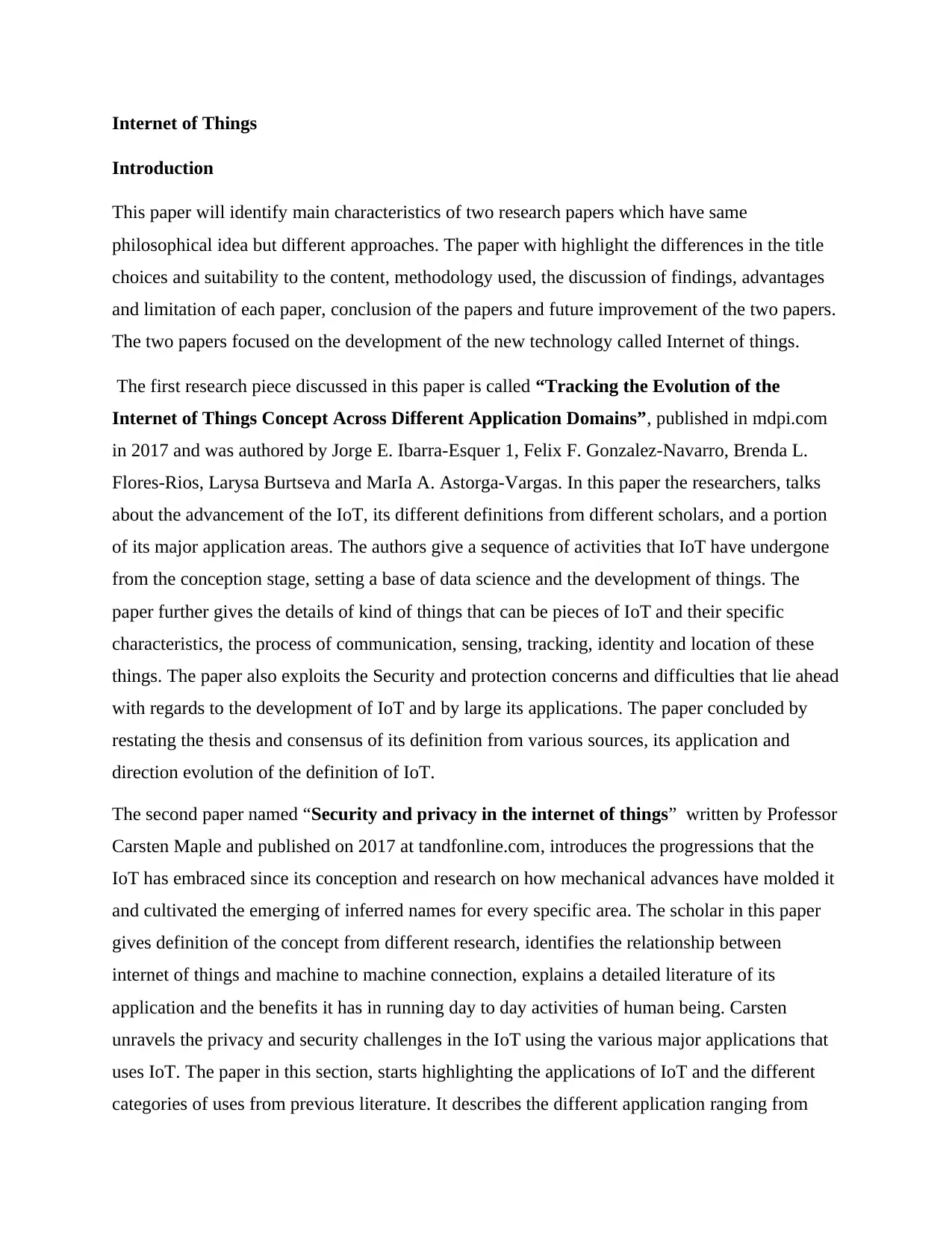
Internet of Things
Introduction
This paper will identify main characteristics of two research papers which have same
philosophical idea but different approaches. The paper with highlight the differences in the title
choices and suitability to the content, methodology used, the discussion of findings, advantages
and limitation of each paper, conclusion of the papers and future improvement of the two papers.
The two papers focused on the development of the new technology called Internet of things.
The first research piece discussed in this paper is called “Tracking the Evolution of the
Internet of Things Concept Across Different Application Domains”, published in mdpi.com
in 2017 and was authored by Jorge E. Ibarra-Esquer 1, Felix F. Gonzalez-Navarro, Brenda L.
Flores-Rios, Larysa Burtseva and MarIa A. Astorga-Vargas. In this paper the researchers, talks
about the advancement of the IoT, its different definitions from different scholars, and a portion
of its major application areas. The authors give a sequence of activities that IoT have undergone
from the conception stage, setting a base of data science and the development of things. The
paper further gives the details of kind of things that can be pieces of IoT and their specific
characteristics, the process of communication, sensing, tracking, identity and location of these
things. The paper also exploits the Security and protection concerns and difficulties that lie ahead
with regards to the development of IoT and by large its applications. The paper concluded by
restating the thesis and consensus of its definition from various sources, its application and
direction evolution of the definition of IoT.
The second paper named “Security and privacy in the internet of things” written by Professor
Carsten Maple and published on 2017 at tandfonline.com, introduces the progressions that the
IoT has embraced since its conception and research on how mechanical advances have molded it
and cultivated the emerging of inferred names for every specific area. The scholar in this paper
gives definition of the concept from different research, identifies the relationship between
internet of things and machine to machine connection, explains a detailed literature of its
application and the benefits it has in running day to day activities of human being. Carsten
unravels the privacy and security challenges in the IoT using the various major applications that
uses IoT. The paper in this section, starts highlighting the applications of IoT and the different
categories of uses from previous literature. It describes the different application ranging from
Introduction
This paper will identify main characteristics of two research papers which have same
philosophical idea but different approaches. The paper with highlight the differences in the title
choices and suitability to the content, methodology used, the discussion of findings, advantages
and limitation of each paper, conclusion of the papers and future improvement of the two papers.
The two papers focused on the development of the new technology called Internet of things.
The first research piece discussed in this paper is called “Tracking the Evolution of the
Internet of Things Concept Across Different Application Domains”, published in mdpi.com
in 2017 and was authored by Jorge E. Ibarra-Esquer 1, Felix F. Gonzalez-Navarro, Brenda L.
Flores-Rios, Larysa Burtseva and MarIa A. Astorga-Vargas. In this paper the researchers, talks
about the advancement of the IoT, its different definitions from different scholars, and a portion
of its major application areas. The authors give a sequence of activities that IoT have undergone
from the conception stage, setting a base of data science and the development of things. The
paper further gives the details of kind of things that can be pieces of IoT and their specific
characteristics, the process of communication, sensing, tracking, identity and location of these
things. The paper also exploits the Security and protection concerns and difficulties that lie ahead
with regards to the development of IoT and by large its applications. The paper concluded by
restating the thesis and consensus of its definition from various sources, its application and
direction evolution of the definition of IoT.
The second paper named “Security and privacy in the internet of things” written by Professor
Carsten Maple and published on 2017 at tandfonline.com, introduces the progressions that the
IoT has embraced since its conception and research on how mechanical advances have molded it
and cultivated the emerging of inferred names for every specific area. The scholar in this paper
gives definition of the concept from different research, identifies the relationship between
internet of things and machine to machine connection, explains a detailed literature of its
application and the benefits it has in running day to day activities of human being. Carsten
unravels the privacy and security challenges in the IoT using the various major applications that
uses IoT. The paper in this section, starts highlighting the applications of IoT and the different
categories of uses from previous literature. It describes the different application ranging from
Secure Best Marks with AI Grader
Need help grading? Try our AI Grader for instant feedback on your assignments.
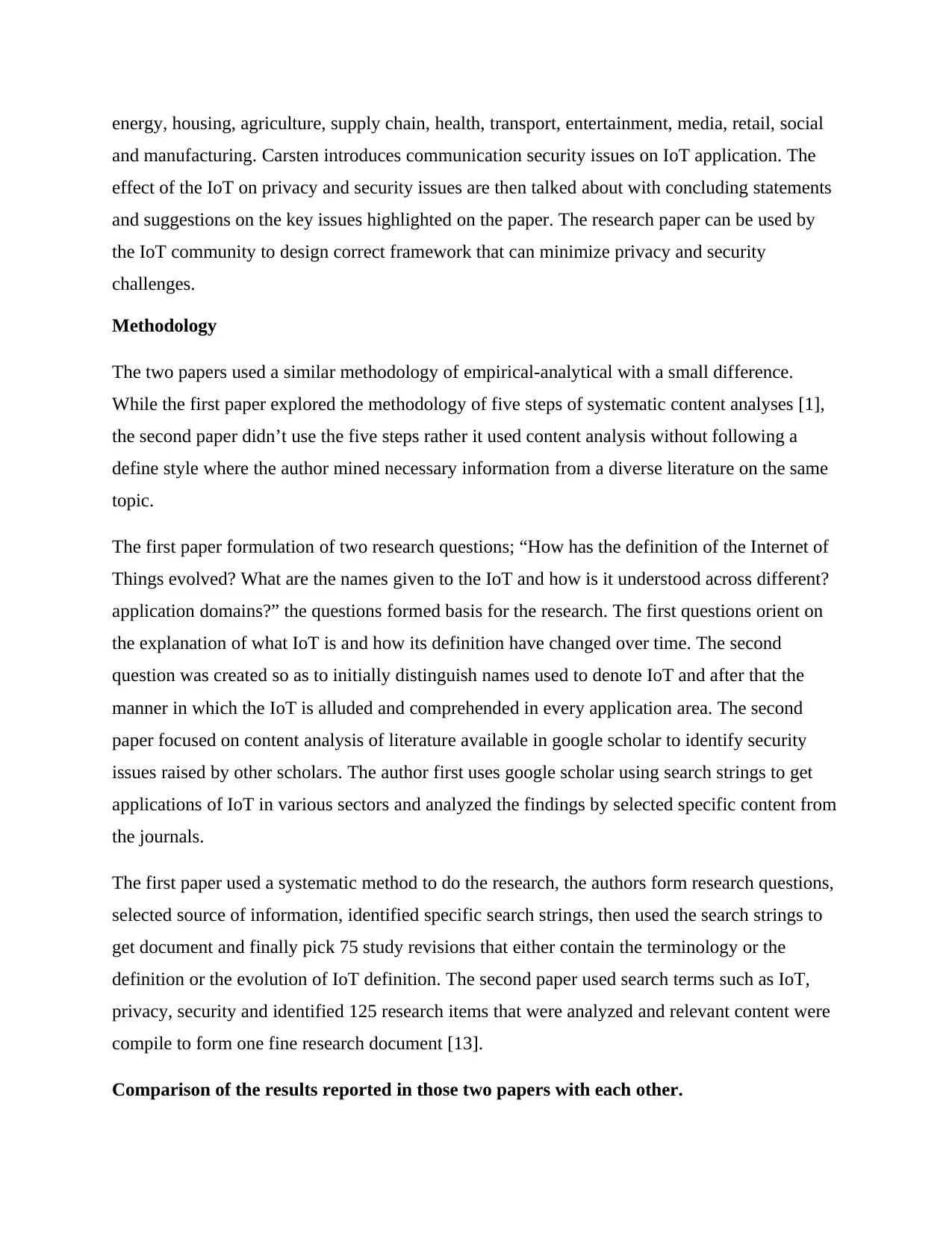
energy, housing, agriculture, supply chain, health, transport, entertainment, media, retail, social
and manufacturing. Carsten introduces communication security issues on IoT application. The
effect of the IoT on privacy and security issues are then talked about with concluding statements
and suggestions on the key issues highlighted on the paper. The research paper can be used by
the IoT community to design correct framework that can minimize privacy and security
challenges.
Methodology
The two papers used a similar methodology of empirical-analytical with a small difference.
While the first paper explored the methodology of five steps of systematic content analyses [1],
the second paper didn’t use the five steps rather it used content analysis without following a
define style where the author mined necessary information from a diverse literature on the same
topic.
The first paper formulation of two research questions; “How has the definition of the Internet of
Things evolved? What are the names given to the IoT and how is it understood across different?
application domains?” the questions formed basis for the research. The first questions orient on
the explanation of what IoT is and how its definition have changed over time. The second
question was created so as to initially distinguish names used to denote IoT and after that the
manner in which the IoT is alluded and comprehended in every application area. The second
paper focused on content analysis of literature available in google scholar to identify security
issues raised by other scholars. The author first uses google scholar using search strings to get
applications of IoT in various sectors and analyzed the findings by selected specific content from
the journals.
The first paper used a systematic method to do the research, the authors form research questions,
selected source of information, identified specific search strings, then used the search strings to
get document and finally pick 75 study revisions that either contain the terminology or the
definition or the evolution of IoT definition. The second paper used search terms such as IoT,
privacy, security and identified 125 research items that were analyzed and relevant content were
compile to form one fine research document [13].
Comparison of the results reported in those two papers with each other.
and manufacturing. Carsten introduces communication security issues on IoT application. The
effect of the IoT on privacy and security issues are then talked about with concluding statements
and suggestions on the key issues highlighted on the paper. The research paper can be used by
the IoT community to design correct framework that can minimize privacy and security
challenges.
Methodology
The two papers used a similar methodology of empirical-analytical with a small difference.
While the first paper explored the methodology of five steps of systematic content analyses [1],
the second paper didn’t use the five steps rather it used content analysis without following a
define style where the author mined necessary information from a diverse literature on the same
topic.
The first paper formulation of two research questions; “How has the definition of the Internet of
Things evolved? What are the names given to the IoT and how is it understood across different?
application domains?” the questions formed basis for the research. The first questions orient on
the explanation of what IoT is and how its definition have changed over time. The second
question was created so as to initially distinguish names used to denote IoT and after that the
manner in which the IoT is alluded and comprehended in every application area. The second
paper focused on content analysis of literature available in google scholar to identify security
issues raised by other scholars. The author first uses google scholar using search strings to get
applications of IoT in various sectors and analyzed the findings by selected specific content from
the journals.
The first paper used a systematic method to do the research, the authors form research questions,
selected source of information, identified specific search strings, then used the search strings to
get document and finally pick 75 study revisions that either contain the terminology or the
definition or the evolution of IoT definition. The second paper used search terms such as IoT,
privacy, security and identified 125 research items that were analyzed and relevant content were
compile to form one fine research document [13].
Comparison of the results reported in those two papers with each other.
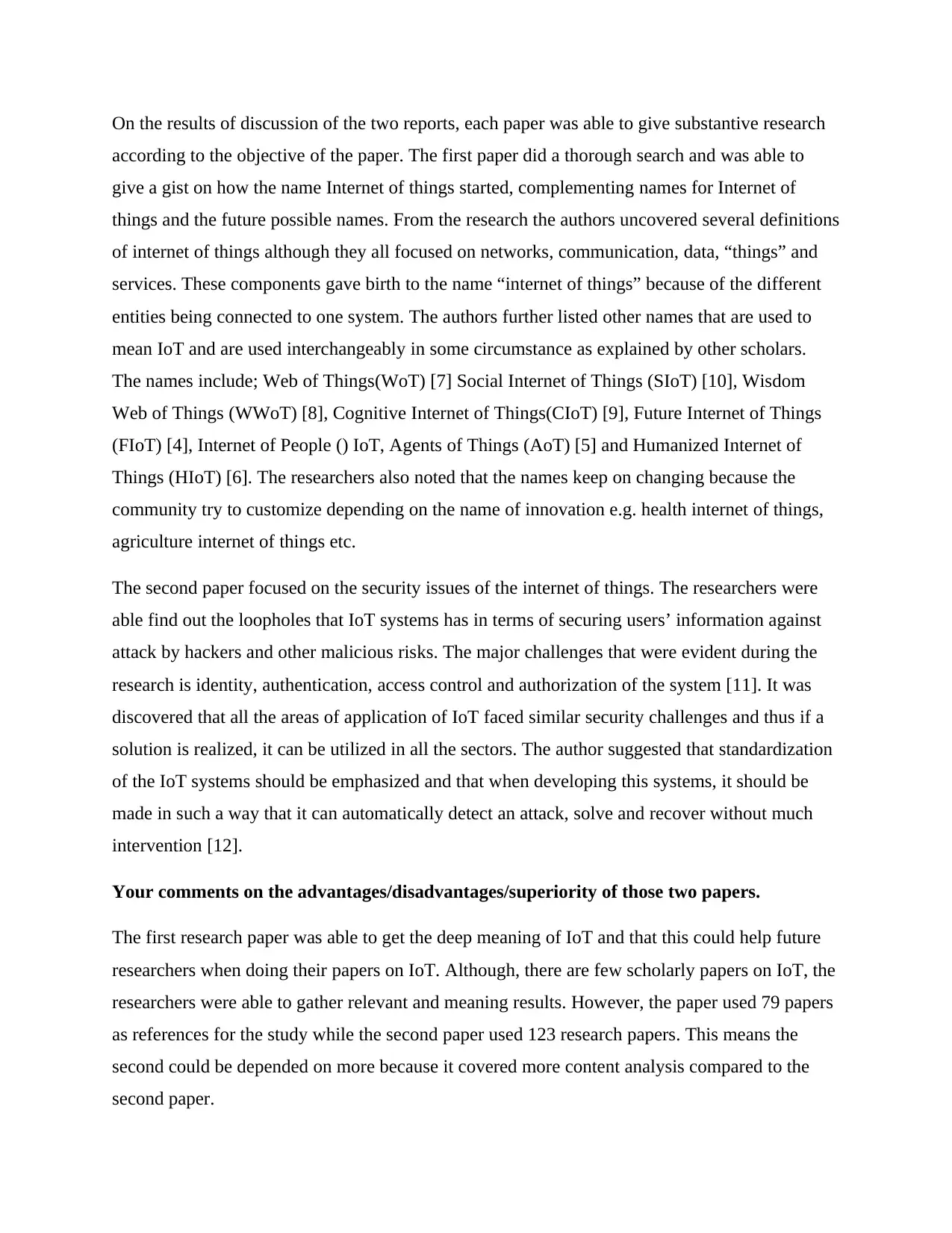
On the results of discussion of the two reports, each paper was able to give substantive research
according to the objective of the paper. The first paper did a thorough search and was able to
give a gist on how the name Internet of things started, complementing names for Internet of
things and the future possible names. From the research the authors uncovered several definitions
of internet of things although they all focused on networks, communication, data, “things” and
services. These components gave birth to the name “internet of things” because of the different
entities being connected to one system. The authors further listed other names that are used to
mean IoT and are used interchangeably in some circumstance as explained by other scholars.
The names include; Web of Things(WoT) [7] Social Internet of Things (SIoT) [10], Wisdom
Web of Things (WWoT) [8], Cognitive Internet of Things(CIoT) [9], Future Internet of Things
(FIoT) [4], Internet of People () IoT, Agents of Things (AoT) [5] and Humanized Internet of
Things (HIoT) [6]. The researchers also noted that the names keep on changing because the
community try to customize depending on the name of innovation e.g. health internet of things,
agriculture internet of things etc.
The second paper focused on the security issues of the internet of things. The researchers were
able find out the loopholes that IoT systems has in terms of securing users’ information against
attack by hackers and other malicious risks. The major challenges that were evident during the
research is identity, authentication, access control and authorization of the system [11]. It was
discovered that all the areas of application of IoT faced similar security challenges and thus if a
solution is realized, it can be utilized in all the sectors. The author suggested that standardization
of the IoT systems should be emphasized and that when developing this systems, it should be
made in such a way that it can automatically detect an attack, solve and recover without much
intervention [12].
Your comments on the advantages/disadvantages/superiority of those two papers.
The first research paper was able to get the deep meaning of IoT and that this could help future
researchers when doing their papers on IoT. Although, there are few scholarly papers on IoT, the
researchers were able to gather relevant and meaning results. However, the paper used 79 papers
as references for the study while the second paper used 123 research papers. This means the
second could be depended on more because it covered more content analysis compared to the
second paper.
according to the objective of the paper. The first paper did a thorough search and was able to
give a gist on how the name Internet of things started, complementing names for Internet of
things and the future possible names. From the research the authors uncovered several definitions
of internet of things although they all focused on networks, communication, data, “things” and
services. These components gave birth to the name “internet of things” because of the different
entities being connected to one system. The authors further listed other names that are used to
mean IoT and are used interchangeably in some circumstance as explained by other scholars.
The names include; Web of Things(WoT) [7] Social Internet of Things (SIoT) [10], Wisdom
Web of Things (WWoT) [8], Cognitive Internet of Things(CIoT) [9], Future Internet of Things
(FIoT) [4], Internet of People () IoT, Agents of Things (AoT) [5] and Humanized Internet of
Things (HIoT) [6]. The researchers also noted that the names keep on changing because the
community try to customize depending on the name of innovation e.g. health internet of things,
agriculture internet of things etc.
The second paper focused on the security issues of the internet of things. The researchers were
able find out the loopholes that IoT systems has in terms of securing users’ information against
attack by hackers and other malicious risks. The major challenges that were evident during the
research is identity, authentication, access control and authorization of the system [11]. It was
discovered that all the areas of application of IoT faced similar security challenges and thus if a
solution is realized, it can be utilized in all the sectors. The author suggested that standardization
of the IoT systems should be emphasized and that when developing this systems, it should be
made in such a way that it can automatically detect an attack, solve and recover without much
intervention [12].
Your comments on the advantages/disadvantages/superiority of those two papers.
The first research paper was able to get the deep meaning of IoT and that this could help future
researchers when doing their papers on IoT. Although, there are few scholarly papers on IoT, the
researchers were able to gather relevant and meaning results. However, the paper used 79 papers
as references for the study while the second paper used 123 research papers. This means the
second could be depended on more because it covered more content analysis compared to the
second paper.
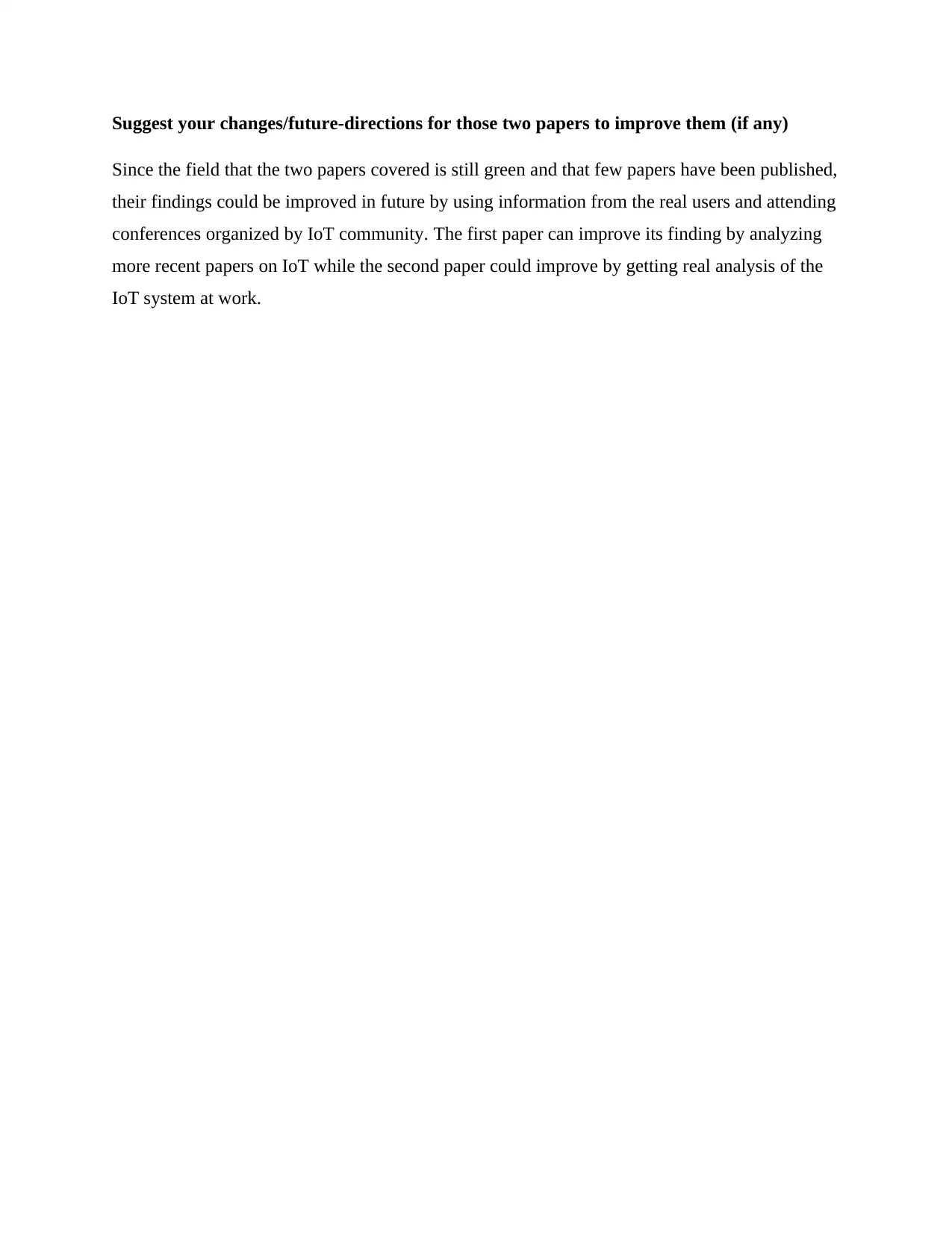
Suggest your changes/future-directions for those two papers to improve them (if any)
Since the field that the two papers covered is still green and that few papers have been published,
their findings could be improved in future by using information from the real users and attending
conferences organized by IoT community. The first paper can improve its finding by analyzing
more recent papers on IoT while the second paper could improve by getting real analysis of the
IoT system at work.
Since the field that the two papers covered is still green and that few papers have been published,
their findings could be improved in future by using information from the real users and attending
conferences organized by IoT community. The first paper can improve its finding by analyzing
more recent papers on IoT while the second paper could improve by getting real analysis of the
IoT system at work.
Secure Best Marks with AI Grader
Need help grading? Try our AI Grader for instant feedback on your assignments.
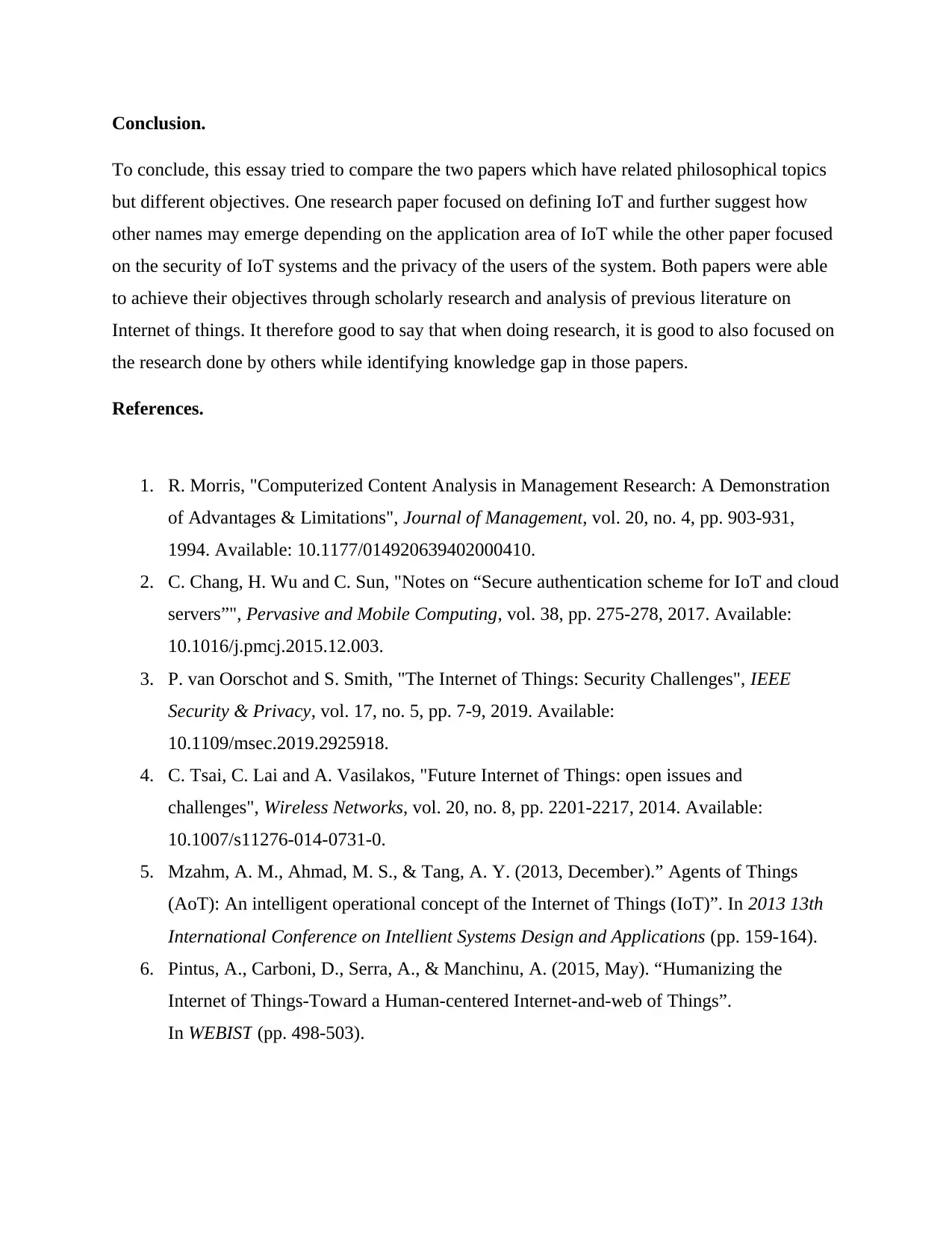
Conclusion.
To conclude, this essay tried to compare the two papers which have related philosophical topics
but different objectives. One research paper focused on defining IoT and further suggest how
other names may emerge depending on the application area of IoT while the other paper focused
on the security of IoT systems and the privacy of the users of the system. Both papers were able
to achieve their objectives through scholarly research and analysis of previous literature on
Internet of things. It therefore good to say that when doing research, it is good to also focused on
the research done by others while identifying knowledge gap in those papers.
References.
1. R. Morris, "Computerized Content Analysis in Management Research: A Demonstration
of Advantages & Limitations", Journal of Management, vol. 20, no. 4, pp. 903-931,
1994. Available: 10.1177/014920639402000410.
2. C. Chang, H. Wu and C. Sun, "Notes on “Secure authentication scheme for IoT and cloud
servers”", Pervasive and Mobile Computing, vol. 38, pp. 275-278, 2017. Available:
10.1016/j.pmcj.2015.12.003.
3. P. van Oorschot and S. Smith, "The Internet of Things: Security Challenges", IEEE
Security & Privacy, vol. 17, no. 5, pp. 7-9, 2019. Available:
10.1109/msec.2019.2925918.
4. C. Tsai, C. Lai and A. Vasilakos, "Future Internet of Things: open issues and
challenges", Wireless Networks, vol. 20, no. 8, pp. 2201-2217, 2014. Available:
10.1007/s11276-014-0731-0.
5. Mzahm, A. M., Ahmad, M. S., & Tang, A. Y. (2013, December).” Agents of Things
(AoT): An intelligent operational concept of the Internet of Things (IoT)”. In 2013 13th
International Conference on Intellient Systems Design and Applications (pp. 159-164).
6. Pintus, A., Carboni, D., Serra, A., & Manchinu, A. (2015, May). “Humanizing the
Internet of Things-Toward a Human-centered Internet-and-web of Things”.
In WEBIST (pp. 498-503).
To conclude, this essay tried to compare the two papers which have related philosophical topics
but different objectives. One research paper focused on defining IoT and further suggest how
other names may emerge depending on the application area of IoT while the other paper focused
on the security of IoT systems and the privacy of the users of the system. Both papers were able
to achieve their objectives through scholarly research and analysis of previous literature on
Internet of things. It therefore good to say that when doing research, it is good to also focused on
the research done by others while identifying knowledge gap in those papers.
References.
1. R. Morris, "Computerized Content Analysis in Management Research: A Demonstration
of Advantages & Limitations", Journal of Management, vol. 20, no. 4, pp. 903-931,
1994. Available: 10.1177/014920639402000410.
2. C. Chang, H. Wu and C. Sun, "Notes on “Secure authentication scheme for IoT and cloud
servers”", Pervasive and Mobile Computing, vol. 38, pp. 275-278, 2017. Available:
10.1016/j.pmcj.2015.12.003.
3. P. van Oorschot and S. Smith, "The Internet of Things: Security Challenges", IEEE
Security & Privacy, vol. 17, no. 5, pp. 7-9, 2019. Available:
10.1109/msec.2019.2925918.
4. C. Tsai, C. Lai and A. Vasilakos, "Future Internet of Things: open issues and
challenges", Wireless Networks, vol. 20, no. 8, pp. 2201-2217, 2014. Available:
10.1007/s11276-014-0731-0.
5. Mzahm, A. M., Ahmad, M. S., & Tang, A. Y. (2013, December).” Agents of Things
(AoT): An intelligent operational concept of the Internet of Things (IoT)”. In 2013 13th
International Conference on Intellient Systems Design and Applications (pp. 159-164).
6. Pintus, A., Carboni, D., Serra, A., & Manchinu, A. (2015, May). “Humanizing the
Internet of Things-Toward a Human-centered Internet-and-web of Things”.
In WEBIST (pp. 498-503).
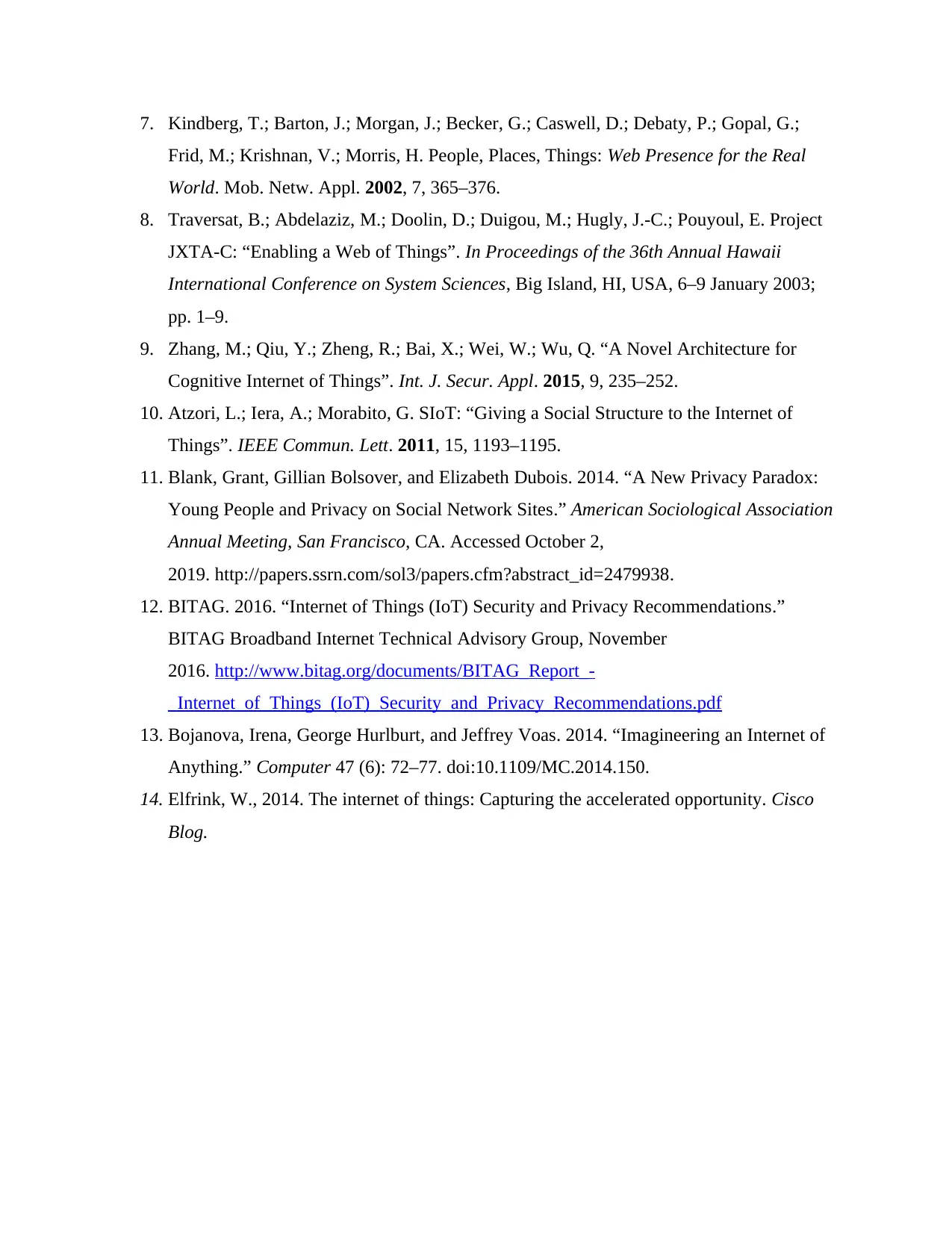
7. Kindberg, T.; Barton, J.; Morgan, J.; Becker, G.; Caswell, D.; Debaty, P.; Gopal, G.;
Frid, M.; Krishnan, V.; Morris, H. People, Places, Things: Web Presence for the Real
World. Mob. Netw. Appl. 2002, 7, 365–376.
8. Traversat, B.; Abdelaziz, M.; Doolin, D.; Duigou, M.; Hugly, J.-C.; Pouyoul, E. Project
JXTA-C: “Enabling a Web of Things”. In Proceedings of the 36th Annual Hawaii
International Conference on System Sciences, Big Island, HI, USA, 6–9 January 2003;
pp. 1–9.
9. Zhang, M.; Qiu, Y.; Zheng, R.; Bai, X.; Wei, W.; Wu, Q. “A Novel Architecture for
Cognitive Internet of Things”. Int. J. Secur. Appl. 2015, 9, 235–252.
10. Atzori, L.; Iera, A.; Morabito, G. SIoT: “Giving a Social Structure to the Internet of
Things”. IEEE Commun. Lett. 2011, 15, 1193–1195.
11. Blank, Grant, Gillian Bolsover, and Elizabeth Dubois. 2014. “A New Privacy Paradox:
Young People and Privacy on Social Network Sites.” American Sociological Association
Annual Meeting, San Francisco, CA. Accessed October 2,
2019. http://papers.ssrn.com/sol3/papers.cfm?abstract_id=2479938.
12. BITAG. 2016. “Internet of Things (IoT) Security and Privacy Recommendations.”
BITAG Broadband Internet Technical Advisory Group, November
2016. http://www.bitag.org/documents/BITAG_Report_-
_Internet_of_Things_(IoT)_Security_and_Privacy_Recommendations.pdf
13. Bojanova, Irena, George Hurlburt, and Jeffrey Voas. 2014. “Imagineering an Internet of
Anything.” Computer 47 (6): 72–77. doi:10.1109/MC.2014.150.
14. Elfrink, W., 2014. The internet of things: Capturing the accelerated opportunity. Cisco
Blog.
Frid, M.; Krishnan, V.; Morris, H. People, Places, Things: Web Presence for the Real
World. Mob. Netw. Appl. 2002, 7, 365–376.
8. Traversat, B.; Abdelaziz, M.; Doolin, D.; Duigou, M.; Hugly, J.-C.; Pouyoul, E. Project
JXTA-C: “Enabling a Web of Things”. In Proceedings of the 36th Annual Hawaii
International Conference on System Sciences, Big Island, HI, USA, 6–9 January 2003;
pp. 1–9.
9. Zhang, M.; Qiu, Y.; Zheng, R.; Bai, X.; Wei, W.; Wu, Q. “A Novel Architecture for
Cognitive Internet of Things”. Int. J. Secur. Appl. 2015, 9, 235–252.
10. Atzori, L.; Iera, A.; Morabito, G. SIoT: “Giving a Social Structure to the Internet of
Things”. IEEE Commun. Lett. 2011, 15, 1193–1195.
11. Blank, Grant, Gillian Bolsover, and Elizabeth Dubois. 2014. “A New Privacy Paradox:
Young People and Privacy on Social Network Sites.” American Sociological Association
Annual Meeting, San Francisco, CA. Accessed October 2,
2019. http://papers.ssrn.com/sol3/papers.cfm?abstract_id=2479938.
12. BITAG. 2016. “Internet of Things (IoT) Security and Privacy Recommendations.”
BITAG Broadband Internet Technical Advisory Group, November
2016. http://www.bitag.org/documents/BITAG_Report_-
_Internet_of_Things_(IoT)_Security_and_Privacy_Recommendations.pdf
13. Bojanova, Irena, George Hurlburt, and Jeffrey Voas. 2014. “Imagineering an Internet of
Anything.” Computer 47 (6): 72–77. doi:10.1109/MC.2014.150.
14. Elfrink, W., 2014. The internet of things: Capturing the accelerated opportunity. Cisco
Blog.
1 out of 6
Your All-in-One AI-Powered Toolkit for Academic Success.
+13062052269
info@desklib.com
Available 24*7 on WhatsApp / Email
![[object Object]](/_next/static/media/star-bottom.7253800d.svg)
Unlock your academic potential
© 2024 | Zucol Services PVT LTD | All rights reserved.





